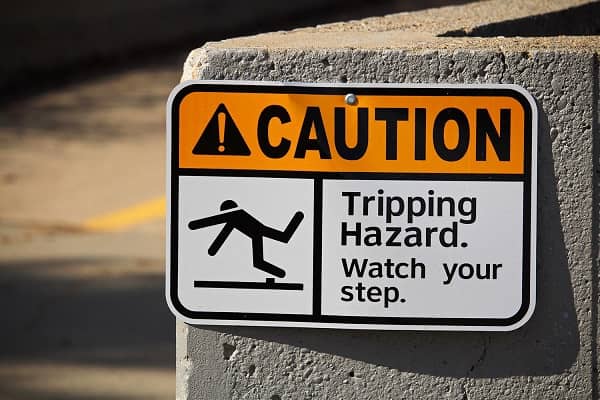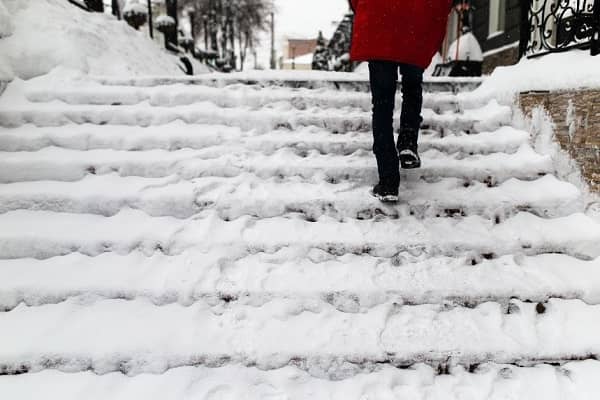Preventing outdoor same level slips, trips, and falls

By properly maintaining sidewalks, parking lots, curbs and other outdoor pedestrian spaces, winter’s slips, trips, and falls can be reduced or eliminated. Slips, trips, and falls in outdoor environments can be caused by rain, sleet, ice and snow, and particulate soil that cause surfaces to become slippery or produce poor traction.
While we cannot control environmental conditions that increase the slipperiness of outdoor walkway surfaces, we can certainly reduce the likelihood of falls through improved design of exterior sidewalks, curbs, parking areas, improved lighting and improved maintenance to increase awareness and eliminate hazards.
Reducing trip hazards
A trip occurs when the foot strikes a near-ground obstacle that abruptly arrests the movement of the foot when the body’s center of gravity is in motion. This causes the center of gravity to rapidly move out of the area of the body's support base (the planted foot), resulting in a fall.A trip most often results in the person falling forward, while a slip most often results in the person falling backward.
Most state, local and federal codes and standards describe changes in level of ¼ inch or higher in the course of travel as a trip hazard. These obstacles should be eliminated through facility design or maintenance, if at all possible. However, if elimination is not possible, other options include:
- For changes in level of ¼ inch to ½ inch, bevel the edge with a slope no greater than 1:2. The slope is the angle of incline, usually given as a ratio of the rise (or vertical height) to the run (or horizontal length). The larger the run, the more gentle the incline angle.
- For level changes greater than ½ inch, install a ramp with a maximum slope of 1:12
- A third, but less desirable option, is to make the hazard noticeable through appropriate detectable warnings

Preventing slips and falls
A business owner may not be responsible for injuries resulting from a fall on a public sidewalk located outside his or her property. However, some courts may impose liability for injuries on a sidewalk used exclusively by customers coming to and from the business. (Consult with your legal counsel if you have questions on liability.)A parking lot owner, however, can be responsible for maintaining the parking lot in a manner such that it is reasonably safe for people using it.
This includes:
- Filling and patching cracks and holes
- Repairing and eliminating raised areas due to tree roots, settling, cold weather and ordinary wear-and-tear
- Reducing surface water by directing roof drainage away from sidewalks and parking areas
- Clearing sidewalks/parking areas of snow/ice before employees and guests arrive
- Centering and securing parking stoppers
- Painting or staining parking stoppers near entrances “safety yellow” to improve visibility
Entrances – For outdoor walkways at entrances exposed to the elements, consider installing a canopy to reduce snow, ice and water from being tracked into the building.
Lighting – Inadequate lighting also may lead to accidents involving falls in parking lots, trips over curbing, falls on a step or stairs from a parking lot to a store and trips and falls due to holes, cracks and uneven surfaces.
By: Mike Huss, Loss Control Consultant
Source: EHS Today by Wayne Maynard

This "document” is intended for general information purposes and should not be construed as advice or opinions on any specific facts or circumstances. The content of this document is made available on an “as is” basis, without warranty of any kind. This document cannot be assumed to contain every acceptable safety and compliance procedure or that additional procedures might not be appropriate under the circumstances. Markel does not guarantee that this information is or can be relied on for compliance with any law or regulation, assurance against preventable losses, or freedom from legal liability. This publication is not intended to be legal, underwriting, or any other type of professional or technical advice. Persons requiring advice should consult an independent adviser or trained professional. Markel does not guarantee any particular outcome and makes no commitment to update any information herein, or remove any items that are no longer accurate or complete. Furthermore, Markel does not assume any liability to any person or organization for loss or damage caused by or resulting from any reliance placed on this content.
Markel® is a registered trademark of Markel Group Inc.
© 2023 Markel Service, Incorporated. All rights reserved.
